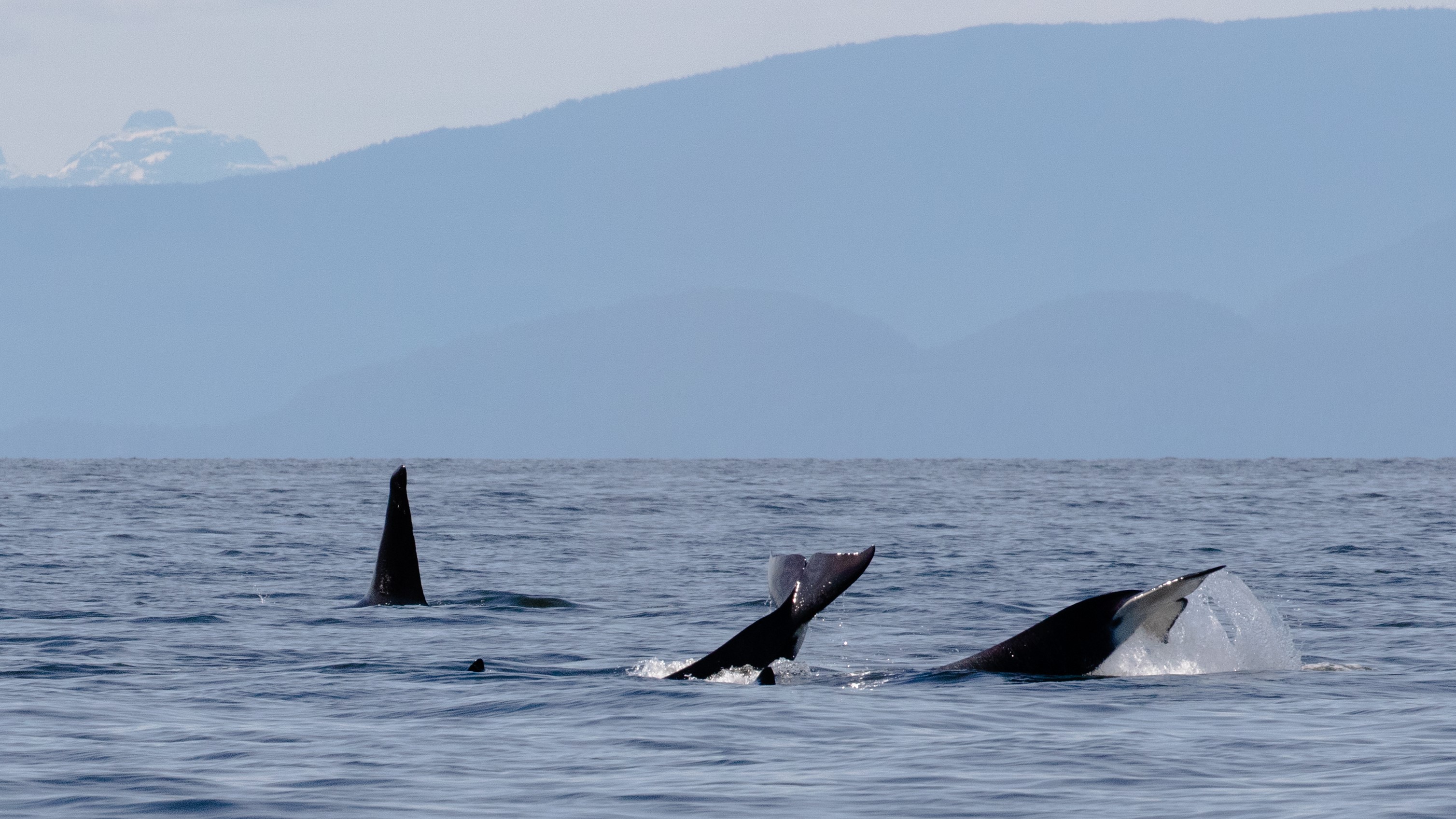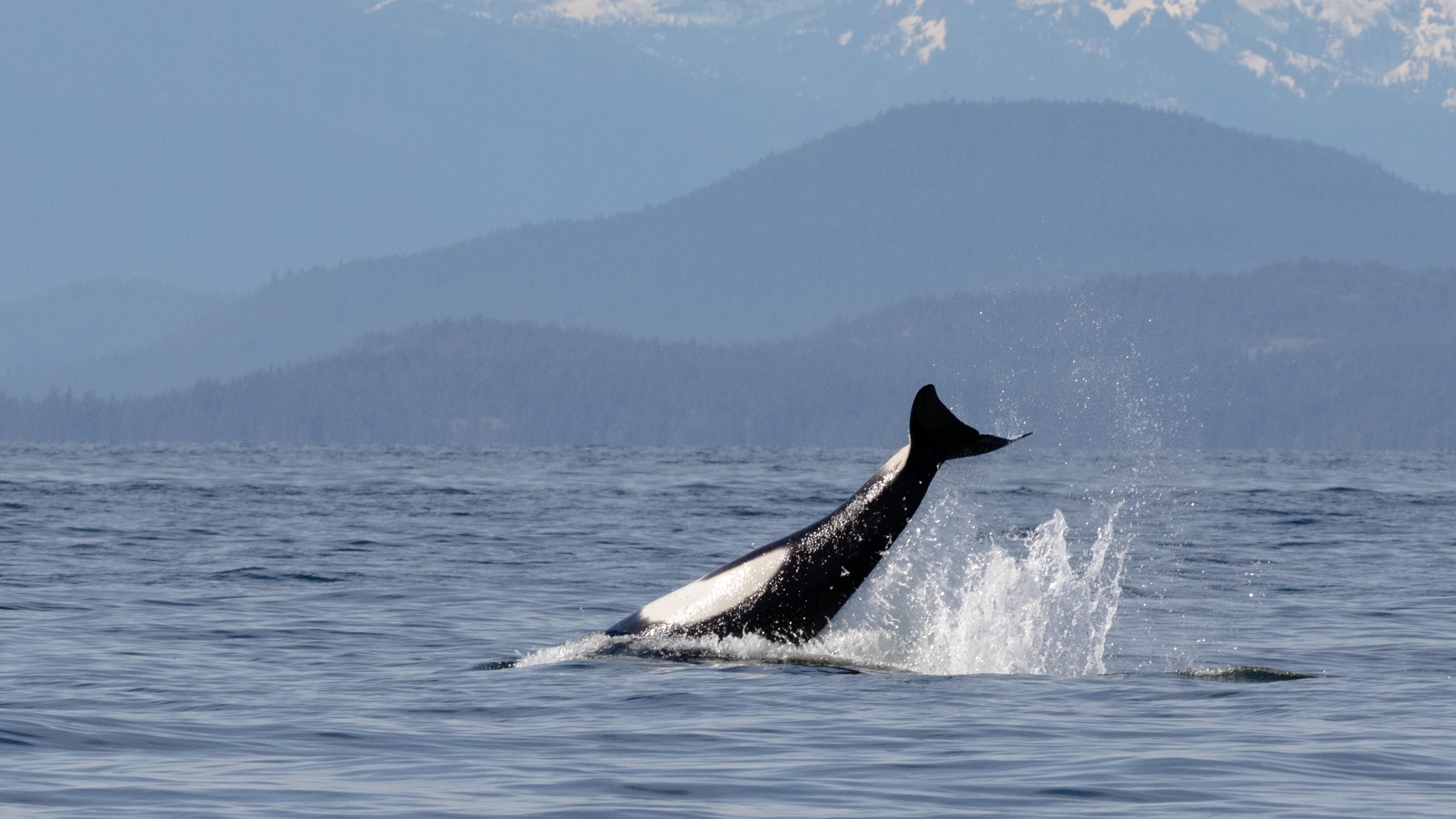Orcas 'attacked' humpback mother and calf. Now the calf is missing.
Experts aren't sure if they were just playing.

Whale watchers in British Columbia recently glimpsed a rare encounter involving a group of orcas seemingly attacking a humpback mother and calf in the Salish Sea.
In video footage captured by a local sailor on May 29 off the coast of Nanaimo on Vancouver Island, the orcas, also known as killer whales, repeatedly slammed against the water near the humpback pair, according to CHEK News.
Witnesses described the 30-minute encounter as an aggressive attack by 13 orcas that may have been targeting the baby humpback. In the footage, one onlooker can be heard saying, "I think they killed the calf." However, there is no evidence that the calf was killed, despite the fact it did not resurface after the attack and has not been seen since, according to Vancouver Island Whale Watch (VIWW), a whale-watching company involved in the subsequent search for these particular humpbacks.
Related: 13 bizarre things that washed up on beaches
"Hopefully, we will see the calf alive and well," Rodrigo Menezes, an oceanographer at VIWW, told CHEK News. "But for now, [there is] a lot of speculation about it."
Cetacean experts are also unsure if this rare encounter really was a deadly battle or just serendipitous splashing among cetaceans.
Transient orcas
The encounter might be considered rare, but orcas are known for their sometimes aggressive behavior toward other marine mammals. In February, for instance, a pod of orcas off the coast of Australia ganged up on and tried to drown a young humpback whale who managed to escape, Live Science reported at the time. In March, a blue whale wasn't so lucky, when 70 killer whales hunted down and killed the mammal off the coast of Australia in an hours-long battle, Live Science also reported.
Get the world’s most fascinating discoveries delivered straight to your inbox.
The recent encounter with humpbacks included so-called transient orcas — those that don't stay in the same area like resident orcas do — from three groups, the T100s, T123s and T46Bs, which range from southeast Alaska to central California, Mark Malleson, a marine biologist at the Center for Whale Research in Washington, told Live Science.
Unlike resident orcas, which feed mainly on salmon, transient orcas are known to target other marine mammals and some seabirds, Malleson said.
Although transient and resident orcas are considered to be the same species, their differing geographic distribution and diets mean they rarely mix and are classified as distinct ecotypes or sub-species, according to the Center for Whale Research.
A rare encounter
Humpback whale numbers are on the rise in the Salish Sea, having only recently returned to the area after heavy commercial whaling in the late 19th and early 20th centuries drove them away, Malleson said. There has also been an increase in the number of transient orcas visiting the area in the last few decades, Malleson said. Those population increases mean there’s "a lot more interaction between humpbacks and killer whales" than in the past, he added.
Any encounters between the two species are also more likely to be documented now because there are "a lot more eyes on the water" due to whale-watching companies like VIWW, Malleson said.
However, despite encounters being on the rise, fatal interactions between orcas and humpbacks are almost unheard of in the area.
"I have seen several interactions between humpbacks and killer whales over the last decade or two," Malleson said. "But not yet a fatal attack."

Fluke news
Did the orcas kill this humpback calf? It is certainly possible, Malleson said.
"If there are enough killer whales to separate the mother from the calf and they are determined, it certainly would be possible," he said. "But I am not convinced that this was the case off of Nanaimo."
Malleson added, "Many people make false interpretations of what they see when killer whales are harassing large whales." If the calf's life had really been at risk, the mother would have tried much harder to deter the orcas, Andrew Trites, a marine mammal researcher at the University of British Columbia, told CHEK News. "Perhaps they [the orcas] were just testing the waters and saw an opportunity."
Although killer whales do slam their bodies into the water's surface to stun their prey, in this case the orcas may have been just playing with the calf, Trites said.
The mother and calf have not been seen in the area since the encounter, VIWW told Live Science in an email. However, "there have also been no sightings of orcas feeding on a humpback carcass afterward, which would have been likely in the event they did attack and kill the calf."
Originally published on Live Science.

Harry is a U.K.-based senior staff writer at Live Science. He studied marine biology at the University of Exeter before training to become a journalist. He covers a wide range of topics including space exploration, planetary science, space weather, climate change, animal behavior and paleontology. His recent work on the solar maximum won "best space submission" at the 2024 Aerospace Media Awards and was shortlisted in the "top scoop" category at the NCTJ Awards for Excellence in 2023. He also writes Live Science's weekly Earth from space series.
